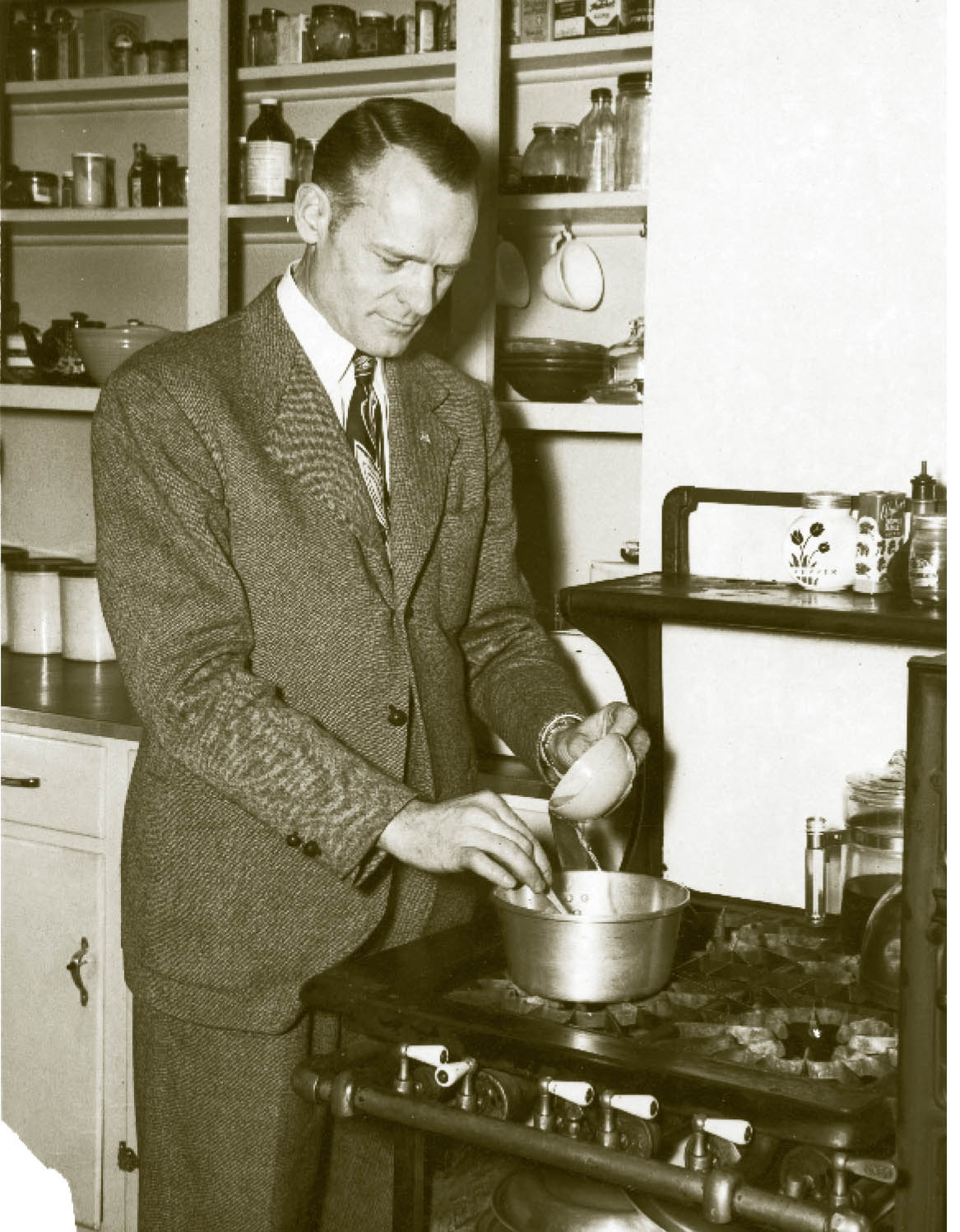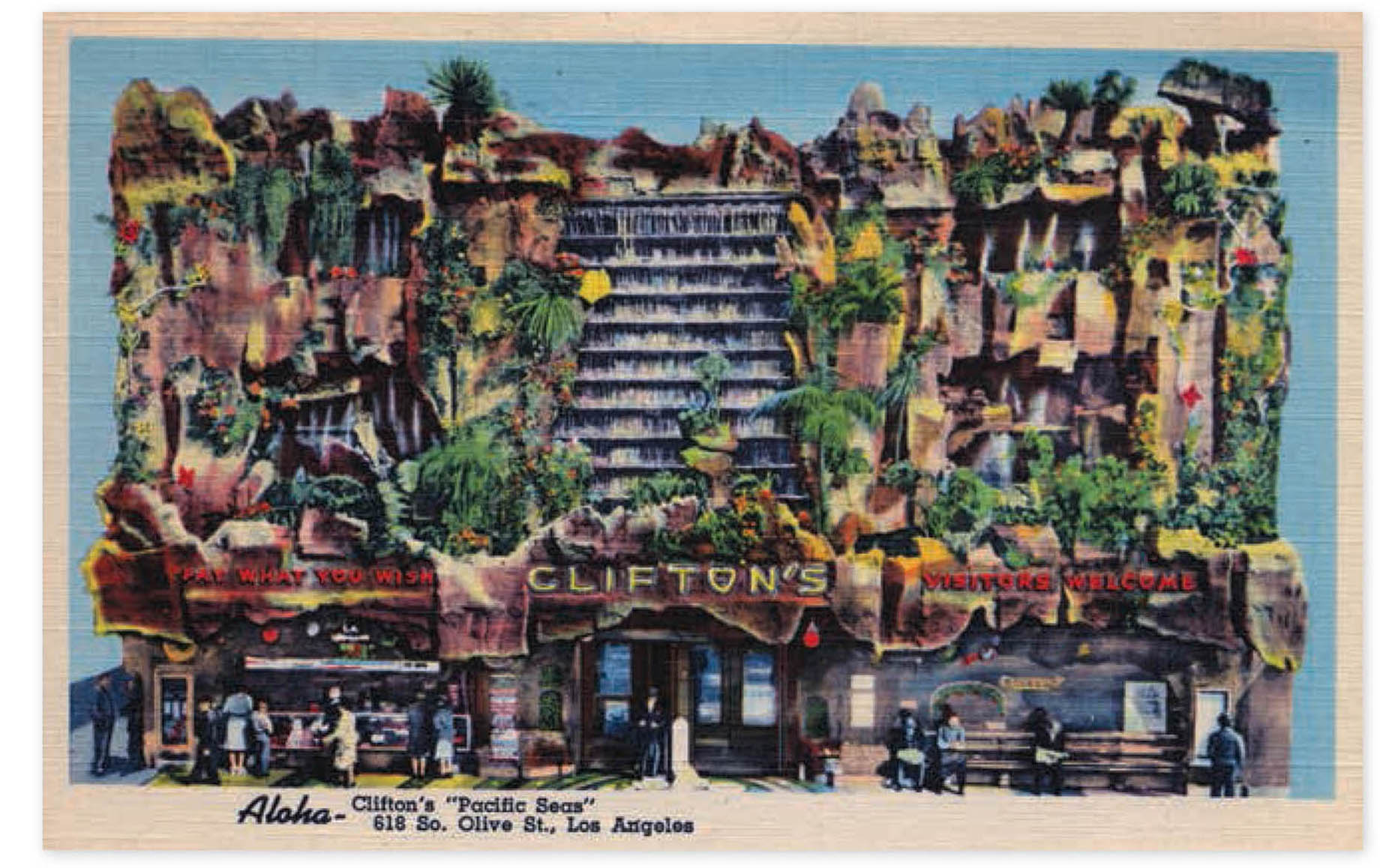OPEN: 1935–2011; 2015–present
LOCATION: 648 S. Broadway Los Angeles, CA 90014
ORIGINAL PHONE: MA7-1673
CURRENT PHONE: (213) 627-1673
CUISINE: Cafeteria
DESIGN: Charles F. Plummer
BUILDING STYLE: Woodland Kitsch

A postcard of Clifton’s Brookdale Cafeteria.
CLIFTON’S BROOKDALE CAFETERIA, ONCE PART OF A CHAIN OF CLIFTON’S RESTAURANTS, IS THE OLDEST SURVIVING CAFETERIA-STYLE RESTAURANT IN LOS ANGELES. The name Clifton’s is a combination of the first and last names of its founder, Clifford Clinton.
Each Clifton’s location had its own theme and look. The first Clifton’s, which opened in 1931 at 618 S. Olive Street, had a Pacific Seas theme, with waterfalls and tropical plants and flowers. The location on Broadway in downtown L.A., which opened four years later in the former Boos Brothers Cafeteria, was named Clifton’s Brookdale and redecorated to resemble a nature lodge Clinton had visited in the Santa Cruz Mountains. Artist Einar C. Petersen created a life-size forest on canvas to cover one wall, and rock sculptor Francois Scotti created a twenty-foot waterfall for the cafeteria that cascaded into a stream flowing past faux redwood trees. Between the trees, you could also find a taxidermied raccoon, a fishing bear, and a moose head.

Clifford Clinton, 1945.
The three-story eatery offered seating for 600 people. Known as the largest public cafeteria in operation, the Brookdale location—one of seven Clifton’s restaurants in the city—remained open for seventy-six years.
Most of the food produced in the mass kitchen is homemade, without the use of mixes or packaged products. The dishes are sold on a pay-per-item basis, and the selection is immense. The menu includes comfort food like creamy mac and cheese, fried chicken with buttermilk biscuits, oxtail stew, turkey and dressing, whipped and fried potatoes, cranberry jewel gelatin, and grilled cheese sandwiches cooked crisp and pressed flat as a pancake.
When it originally opened, Clifton’s maintained a precedent known as Clifton’s Golden Rule, which was “Dine Free Unless Delighted.” Determined to make an impact on world hunger, Clifford Clinton worked with the California Institute of Technology to develop what they called “Multi-Purpose Meals”—high-protein, nutritious meals that could be sold at Clifton’s for just a nickel per serving. During the war years, the cafeteria served upwards of 10,000 customers, with lines wrapping around the block. The restaurant never turned anyone away hungry. During one ninety-day period, Clifton’s served 10,000 free meals, and then decided to open up an emergency “Penny Cafeteria” a few blocks away from the Broadway location, with the help of vendors and generous suppliers. By 1940, the cafeterias were serving up to 25,000 meals a day.

Pictorial showing a woman eating Clifton’s Multi-Purpose Food, 1950.
One notable patron of the Brookdale cafeteria was science fiction writer Ray Bradbury. The author spent his afternoons writing at the Los Angeles Central Library, and then would walk the few blocks down to Clifton’s for lunch. Many times, he would take advantage of the Clifton’s policy that anyone who couldn’t afford to pay didn’t have to. In the 1930s, Bradbury visited Clifton’s to attend meetings of the Los Angeles Science Fiction Society, which met on the third floor for years. Bradbury also celebrated his eighty-ninth birthday at Clifton’s in 2009.

Postcard showing the Clifton’s Pacific Seas location.

The Clifton’s Brookdale facade, 1940.
In 1935, L.A. County Supervisor John Anson Ford inadvertently inserted Clifford Clinton into the political arena by asking him to investigate food operations at the County General Hospital. After Clinton submitted his report that patients were being served food that was low-quality at best and rancid at worst, Clifton’s was suddenly inundated with health inspections and complaints about food poisoning. Clinton did not take these attacks lying down. He formed a committee to investigate vice in the city, exposing bribery and other illegal activity taking place at City Hall. Clinton remained involved in politics for the rest of his life—despite literal death threats, such as the bomb that exploded in his basement in 1937.
In 1946, Clinton and his wife, Nelda, sold the cafeteria interest to their three children and retired to devote their attention to their nonprofit charitable organization, “Meals for Millions,” which they had founded in the middle of World War II. The organization distributed food to millions of hungry and malnourished people throughout the world.
Clinton died peacefully in his Los Angeles home in 1969, at the age of sixty-nine. He was buried at Forest Lawn Cemetery in Glendale. After his death, Clinton’s cafeterias closed one by one, until finally only the Clifton’s location on Broadway remained.
In 2006, Robert Clinton took final steps to purchase the Clifton’s Brookdale building that he had been leasing for seventy-one years. In 2010, Andrew Meieran, owner of the Edison nightclub in downtown L.A., bought Clifton’s Brookdale and renovated the place with the aim of preserving the food and history of the establishment, including some of its original recipes from the 1950s. The renovated Clifton’s, which opened in 2015, retains many of its original design features, including the forest theme, taxidermied animals, and the woodland mural on the wall. 
![]()